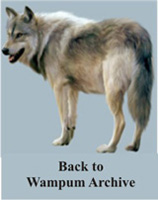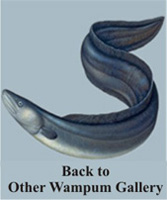 |
 |
Photographs (left to right): Sunset, Albuquerque, New Mexico; Silver Pennies, Rush, New York; Tent Rocks National Monument, New Mexico
Wampum Belt Archive
Hypothecial image from Wm. Johnson Description'
R.D. Hamell Jan. 02, 2023
William Johnson 1756 Alliance Belt
Original Size: |
Not given. |
Reproduction: |
Beaded Length: 37.0 inches. Width: 6.0 inches. Length with fringe: 66.5 inches. |
Beads: |
Columns: 220. Rows: 9. Beads: 1,980. |
Materials: |
Warp: Deer Leather. Weft: Artificial Sinew. Beads: Polymer. |
Description:
WJ 1756: The William Johnson Belt.
On 17 October 1763 William Johnson presented to his "Bretheren of
Oghquago, and the rest" (possibly Oneida and Tuscarora) a specific belt bearing
the date 1756, suggesting that the belt had been made some seven years
earlier. Thus, although this 1763 transfer marks the first appearance of the
belt in the historical record, the date inscribed on it indicates that Johnson
used a belt that had been made and presented, or circulated, one or more
times prior to this recorded event. Johnson's presentation of this specific belt
in 1763 was made in support of his request to his Native allies that they gather
news of the activities of other Native groups, particularly of the "Delaware"
and the "Shawanese." Both of these groups were nominal allies of the English,
but Johnson and others distrusted Teedyuscung and
those evil minded & foolish People the Delawares &ca.
"I must desire
by this Belt of Wampum that You will lay yourselves out for procureing
all the Intelligence you possibly can. . . . I expect to See this Belt with
my name & year 1756, wh. I now give you[,] whenever You Send me
any news, that then I may know it comes from Your Chiefs.
—A Black Belt marked WJ 1756
Johnson's mistrust of this "Delaware"-Shawnee alliance was well founded.
In 1755 the Lenopi had sided with the French against the English. When
these Lenopi, here glossed as "Delaware," observed that the French could
barely feed their own troops and had little to offer their Indian allies, they
immediately switched sides. Later, perhaps as a result of their new alliance
with the English, these "Delaware" and Shawnee became important players in
the fur trade. They maintained a strong political and military union at least
through the end of the eighteenth century, and frequent note was made of
their raids on white settlements and farmsteads along the frontier.32 Lainey
recently discovered information revealing that the WJ 1756 belt had been in
the hands of the Oneidas and that it was used again in 1775 when they presented
it to Guy Johnson. In 1775 it was described as "a Black belt of [9] Rows
with the letter [sic] W I & 1756 in White on it." This information and the original
texts are still under study.
Jean-Pierre Sawaya also reviews information relating to Sir William
Johnson's presentation of the WJ 1756 belt. Sawaya attributes the date of 1756
on the belt to the year in which Johnson was appointed superintendent for
Indian affairs by the English government.33 Beauchamp states that "another
of Johnson's lettered belts is elsewhere mentioned" along with mention of
Johnson's 1759 example cited below.34 This might be the WJ 1756 belt or
another one with a later date. Unfortunately, Beauchamp provides no indication
of his source for this information.
Reference:
Becker, Marshall J. & Lainey, Jonathan. 2004. Wampum Belts with Initials and/or Dates. American Indian Culture and Research Journal. 28 (2).
 |
 |
 |
 |
 |
 |
 |
 |
|---|
